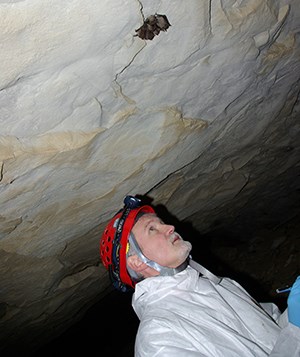
Steve Thomas, Network Program Manager
(270) 758-2160; Email
Cave vital signs monitoring program leader. Protocol development, implementation, data analysis, and reporting for cave monitoring protocols.
Active Projects: Allegheny Woodrats, Cave Bats
MS, Biology/Applied Ecology, Eastern Kentucky University
BA, Biology (Environmental and Research Options), Covenant College

Clare Bledsoe, Biologist
(270) 758-2133, Email
BS, Forest Science, University of Wisconsin
Certificate in Environmental Studies, University of Wisconsin
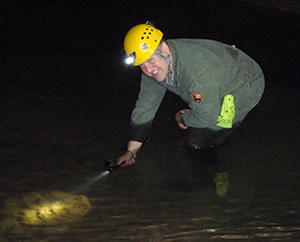
Kurt Helf, Ecologist
(270) 758-2163, Email
Primary Network Responsibilities: Protocol development, data analysis, and reporting for cave crickets and cave aquatic biota resources for the Cumberland Piedmont Network.
Active Projects: Long-term monitoring of cave cricket entrance populations at Mammoth Cave National Park, Long-term monitoring of cave aquatic biota at Cumberland Gap National Historical Park, Mammoth Cave National Park, and Russell Cave National Monument.
Education and Areas of Expertise:
Ph.D. Ecology, University of Illinois at Chicago
BS, Biology, University of Illinois at Chicago
Prior to working for CUPN I was an ecologist for the I&M prototype program at Mammoth Cave National Park where I worked on resource management including insect inventory, mussel aquaculture, mercury ecotoxicology, and cave ecology. My primary area of expertise is cave aquatic and terrestrial community ecology.
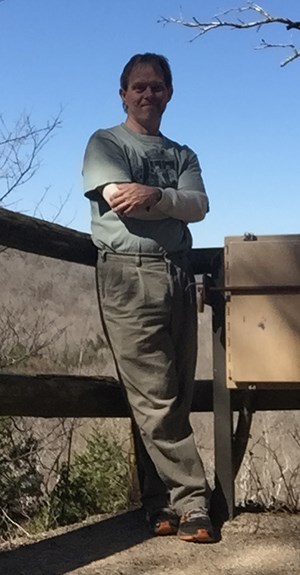
Johnathan Jernigan, Physical Scientist
(270) 758-2146; Email
Primary Network Responsibilities: Protocol development, data collection, data analysis and reporting for ozone foliar injury. Also, assist with data collection and analysis of cave meteorology data for cave bats and cave crickets protocols. Assist with data collection on water quality and vegetation protocols.
Active Projects: Ozone Foliar Injury, Cave Meteorology
Education and Areas of Expertise:
MS, Mathematics, Western Kentucky University
BA, Mathematics, Western Kentucky University
I studied the mathematical relationship between air temperature and wind patterns in parts of Mammoth Cave as part of my thesis work. Then, I worked as an Instructor of Mathematics at Western Kentucky University. I have since been working with the Cumberland Piedmont Network and also collect surface air quality data at Mammoth Cave National Park. I enjoy listening to music, watching movies, reading, riding roller coasters, bicycling and hiking.

Bill Moore, Supervisory Ecologist
(270) 758-2161, Email
Primary Network Responsibilities: Project lead for forest vegetation monitoring and data management support to the network
Education and Areas of Expertise:
MS, Wildlife Science w/minor in Range Science, New Mexico State University
BS, Wildlife Management, Eastern Kentucky University
Prior to working for the National Park Service, Bill worked as a regional nongame biologist for the Kentucky Department of Fish and Wildlife Resources primarily working with herps, bats and birds. He also spent a few years working as a rangeland specialist for the Bureau of Land Management in Medford, Oregon, and as a wildlife specialist in New Mexico focused primarily on T&E issues.
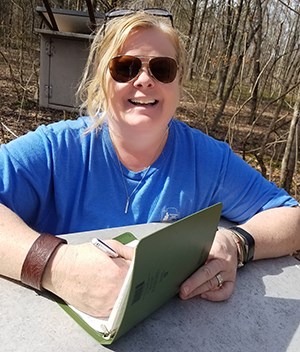
(270) 758-2149, Email
Primary Network Responsibilities: CUPN GIS Specialist for 14 network parks providing GIS and GPS assistance as necessary for inventory projects.
Active Projects: Water quality, Air Quality, Cave Aquatic Biota, Vegetation, Cave Crickets, Bats and Park NRCAs
Education and Areas of Expertise:
BS, Horticulture/Agriculture, Western Kentucky University
GIS Certificate, Western Kentucky University
Prior to working for CUPN, I started my career with the park service at Mount Rushmore as an interpretation ranger in 1997. From there I spent two seasons at Sleeping Bear Dunes National Lakeshore in various divisions; including interpretation, fee collection, maintenance, firefighting and dispatch. My last season before I ended up at my home park of Mammoth Cave National Park (MACA), was spent on Little Cranberry Island at Acadia National Park. I worked at MACA as a temporary secretary for the Science and Resource Management division. I was then hired on at MACA for a six month Student Conservation Association (SCA) GIS intern. Once my SCA position was complete, I was put into a student program currently called NPS Pathways. I then attended Western Kentucky University and completed my GIS Certificate program in 2002. After which I became a 50/50 split GIS Specialist for CUPN and MACA.
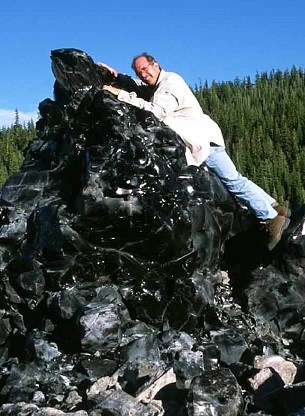
(270) 758-2135, Email
Primary Network Responsibilities: Support all vital sign monitoring protocols with data management (database development and maintenance) and data quality.
Education and Areas of Expertise:
M.S. Marine Science, University of South Carolina
B.S. Marine Science, Jacksonville University
Prior to joining CUPN in 2022, I worked for Southwest Alaska Network. Taking advantage of the Park Service with units across the country, I've also worked for Northern Great Plains Network, Northeast Temperate Network, Glacier National Park, Klamath Network, and Everglades National Park. I also spend time getting muddy collecting data in the salt marshes of Georgia.
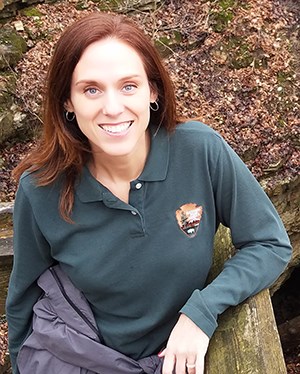
Brenda Wells, Biologist
(270) 758-2134; Email
Active Projects: Water quality, Natural History Collections, Website Management
Education and Areas of Expertise:
I started working with Natural History Collections in curatorial at Mammoth Cave National Park for my graduate assistantship in 2000. In 2004 I was able to move into a position with the Cumberland Piedmont Network, stationed at MACA, working with I & M collections for the network’s 14 parks. My position then expanded to help with the water quality program; sampling, testing, and data entry. I really enjoy being with family outdoors, camping, hiking, biking and art.
Last updated: November 18, 2024
